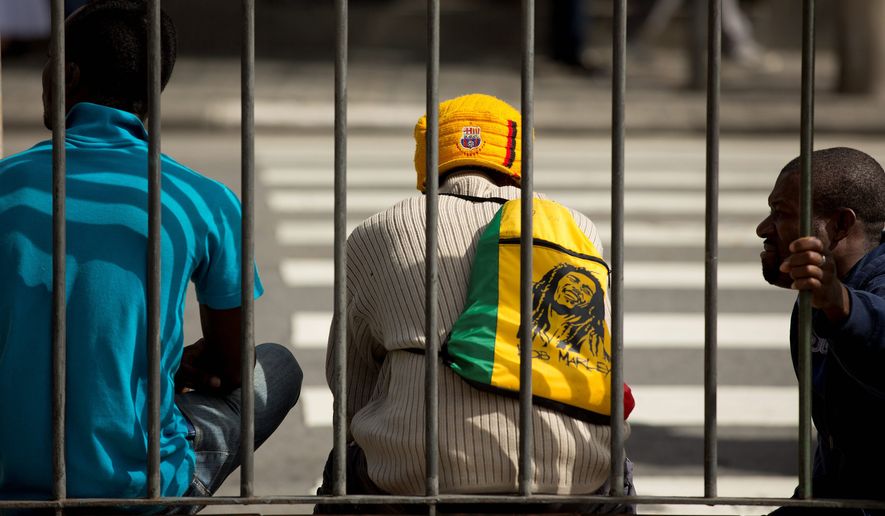Haitian immigrants are surging across America’s southwest border, blazing a path through Mexico to the U.S., where they have been coached to claim asylum, earning them quick processing and almost immediate entry into the country.
Analysts called it a backdoor amnesty that’s increasingly being abused by illegal immigrants who normally would have no shot of staying in the U.S., but who, by claiming asylum, can gain a foothold here. The Haitians are the latest to discover the route, likely encouraged by smugglers who stand to make thousands of dollars from each migrant they transport through Mexico and up to the U.S. land border.
A video obtained by Rep. Duncan Hunter, California Republican, which originated with U.S. Customs and Border Protection, shows Haitians massing outside of a Mexican detention facility on that country’s border with Guatemala, ahead of what analysts said was likely a long journey north to the U.S.
“It’s a method for backdoor entry that presents a real exposure, because it’s virtually open to anyone to enter the U.S. without any real scrutiny or undergoing the regular process,” said Joe Kasper, chief of staff to Mr. Hunter. “The fact that 300 Haitians show up in Mexico and from that point are virtually guaranteed entry into the U.S. underscores one of many major problems with the president’s immigration policy — and Americans need to recognize it.”
The new surge has overwhelmed American authorities, and sources said Customs and Border Protection has imposed a cap of 150 Haitian asylum-seekers a day at San Ysidro, America’s busiest Mexican-border crossing.
Haitians have been given special treatment since the January 2010 earthquake that decimated the island nation’s government and devastated its infrastructure. Haitians who were in the U.S. by January 2011 were given Temporary Protected Status, allowing them to stay, while illegal immigrants who came after that were generally overlooked.
But the new surge on the southwest border has alarmed Homeland Security officials, who tried to send a signal back to Haiti on Thursday.
Secretary Jeh Johnson announced that his deportation agents would once again begin deporting Haitian illegal immigrants picked up at the border through a process known as expedited removal. But Mr. Johnson said those claiming asylum will still be allowed to make their case.
“Consistent with law, individuals who express a fear of return to Haiti will be screened by a U.S. Citizenship and Immigration Services (USCIS) asylum officer to determine whether they possess a credible fear of persecution or torture. Those determined to have a credible fear will be referred to immigration court for removal proceedings where they may apply for asylum or other forms of relief,” Mr. Johnson said in a statement.
Those cases usually require an immigration judge to get involved, and the proceedings last for years, giving the illegal immigrants a foothold in the U.S.
“They know that if they show up for that court date, they might get asylum. If they don’t show up, nothing’s going to happen,” said Jessica Vaughan, policy studies director at the Center for Immigration Studies. “It’s been made perfectly clear to everyone that if you’re not a serious criminal, you are not going to face deportation.”
The Haitian embassy didn’t return messages seeking comment on the new surge of people fleeing their homes to try to reach the U.S.
Mexican officials, meanwhile, said Wednesday that they would seek answers to questions from The Washington Times, but hadn’t provided answers by Thursday night.
In this case, the situation has forged better cooperation between the U.S. and Mexico, including building temporary housing at the San Ysidro crossing, which Homeland Security officials said is used in handling surges, to keep the migrants from exposure to the elements while they wait for a chance to make their claims in the U.S.
Analysts said Haitians find it difficult to get visas to enter the U.S. but relatively easy to get visas to enter Central America. So they go there, then hook up with smugglers who bring them through Mexico and up to the U.S. border, where the migrants make their claims of asylum.
The video obtained by Mr. Hunter’s office shows Haitians at the southern end of that journey at Tapachula, a city at the tip of Mexico on the border with Guatemala. From there, it’s a 2,500-mile journey to San Ysidro, the border crossing into the U.S. that’s become popular for Haitians.
Rep. Scott H. Peters, a California Democrat who represents San Diego, said at a hearing Thursday that his city is playing host to some 4,000 Haitians right now. Immigration and Customs Enforcement Director Sarah Saldana said they are posing a problem.
“Those and the other increased numbers of families from Central America are really taxing our resources,” she said.
Ms. Vaughan said the asylum-seekers should be applying for status from Mexico, which is supposed to accept them, rather than continuing on to the U.S.
She said until the 1990s, the U.S. had a policy of turning asylum-seekers at the Mexico border away, telling them to make an appointment with U.S. consular officials in Mexico City. That had the effect of weeding out those without valid cases, she said.
But under the current policy, asylum applications have skyrocketed, both in defensive claims made in the interior of the U.S. and affirmative applications made at the border.
In 2013 the government recorded about 3,000 credible fear referrals a month — the process Mr. Johnson mentioned for claiming asylum at the border. So far this year the number is nearly 5,500 referrals a month.
“It’s nuts. It’s a backdoor immigration program,” Ms. Vaughan said. “Our government is facilitating the movement of people into the country who are going to end up as illegal aliens.”
• Stephen Dinan can be reached at sdinan@washingtontimes.com.




Please read our comment policy before commenting.